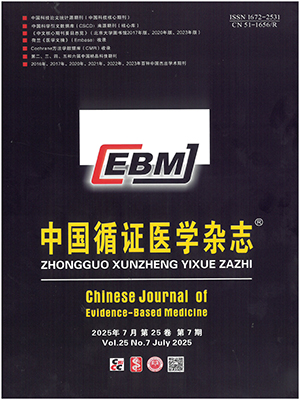| 1. |
Chen Y, Wang C, Shang H, et al. Clinical practice guidelines in China. BMJ, 2018, 360: j5158.
|
| 2. |
McMillan Boyles C, Spoel P, Montgomery P, et al. Representations of clinical practice guidelines and health equity in healthcare literature: an integrative review. J Nurs Scholarsh, 2023, 55(2): 506-520.
|
| 3. |
Cabana MD, Rand CS, Powe NR, et al. Why don't physicians follow clinical practice guidelines? A framework for improvement. JAMA, 1999, 282(15): 1458-1465.
|
| 4. |
Moulds RF. Clinical practice guidelines: the need for greater transparency in formulating recommendations. Med J Aust, 2011, 195(6): 324-325.
|
| 5. |
Scott IA, Guyatt GH. Clinical practice guidelines: the need for greater transparency in formulating recommendations. Med J Aust, 2011, 195(1): 29-33.
|
| 6. |
Dewidar O, Kawala BA, Antequera A, et al. Methodological guidance for incorporating equity when informing rapid-policy and guideline development. J Clin Epidemiol, 2022, 150: 142-153.
|
| 7. |
Chen Y, Yang K, Marušic A, et al. A reporting tool for practice guidelines in health care: the RIGHT statement. Ann Intern Med, 2017, 166(2): 128-132.
|
| 8. |
O'Shaughnessy SM, Lee JY, Rong LQ, et al. Quality of recent clinical practice guidelines in anaesthesia publications using the appraisal of guidelines for research and evaluation Ⅱ instrument. Br J Anaesth, 2022, 128(4): 655-663.
|
| 9. |
Morgano GP, Mbuagbaw L, Santesso N, et al. Defining decision thresholds for judgments on health benefits and harms using the grading of recommendations assessment, development and evaluation (GRADE) evidence to decision (EtD) frameworks: a protocol for a randomised methodological study (GRADE-THRESHOLD). BMJ Open, 2022, 12(3): e053246.
|
| 10. |
Wayant C, Cooper C, Turner D, et al. Evaluation of the NCCN guidelines using the RIGHT statement and AGREE-Ⅱ instrument: a cross-sectional review. BMJ Evid Based Med, 2019, 24(6): 219-226.
|
| 11. |
杨柳, 龙囿霖, 程祎凡, 等. 临床实践指南透明度评价工具的循证构建. 中国循证医学杂志, 2021, 21(8): 869-875.
|
| 12. |
Niederberger M, Köberich S, . Coming to consensus: the Delphi technique. Eur J Cardiovasc Nurs, 2021, 20(7): 692-695.
|
| 13. |
Improta G, Perrone A, Russo MA, et al. Health technology assessment (HTA) of optoelectronic biosensors for oncology by analytic hierarchy process (AHP) and Likert scale. BMC Med Res Methodol, 2019, 19(1): 140.
|
| 14. |
王春枝, 斯琴. 德尔菲法中的数据统计处理方法及其应用研究. 内蒙古财经学院学报(综合版), 2011, 9(4): 92-96.
|
| 15. |
王桾蔓, 文进. 应用德尔菲法构建地震灾区健康融入所有政策评价指标体系. 中国循证医学杂志, 2021, 21(7): 754-759.
|
| 16. |
Kursa MB. Kendall transformation brings a robust categorical representation of ordinal data. Sci Rep, 2022, 12(1): 8341.
|
| 17. |
张帅, 张守琳, 邹迪, 等. 基于德尔菲法及层次分析法构建IgA肾病气阴两虚证条目权重. 世界科学技术-中医药现代化, 2023, (7): 1-9.
|
| 18. |
Costa DS, Mamede HS, da Silva MM. A method for selecting processes for automation with AHP and TOPSIS. Heliyon, 2023, 9(3): e13683.
|
| 19. |
Liang J, Zou G, Gu C, et al. Study on skin infection model of Staphylococcus aureus based on analytic hierarchy process and Delphi method. Heliyon, 2023, 9(6): e16327.
|
| 20. |
Saaty TL. Decision making with the analytic hierarchy process. Int J Serv Sci, 2008, 1(1): 83-98.
|
| 21. |
Peng G, Han L, Liu Z, et al. An application of fuzzy analytic hierarchy process in risk evaluation model. Front Psychol, 2021, 12: 715003.
|
| 22. |
Bassand JP, Hamm C. Guidelines for anticoagulant use in acute coronary syndromes. Lancet, 2008, 372(9638): 532-533.
|
| 23. |
Norris SL, Holmer HK, Ogden LA, et al. Conflict of interest in clinical practice guideline development: a systematic review. PLoS One, 2011, 6(10): e25153.
|
| 24. |
Tabatabavakili S, Khan R, Scaffidi MA, et al. Financial conflicts of interest in clinical practice guidelines: a systematic review. Mayo Clin Proc Innov Qual Outcomes, 2021, 5(2): 466-475.
|
| 25. |
陈耀龙, 王健健, 詹思延, 等. 如何应对指南制订中的利益冲突. 协和医学杂志, 2019, 10(6): 685-691.
|
| 26. |
Burgers JS, Grol R, Klazinga NS, et al. Towards evidence-based clinical practice: an international survey of 18 clinical guideline programs. Int J Qual Health Care, 2003, 15(1): 31-45.
|
| 27. |
van den Bergh RCN, Ost P, Surcel C, et al. Are clinical guidelines designed according to guidelines? Cross-sectional assessment of quality and transparency of clinical guidelines in urology. World J Urol, 2018, 36(9): 1489-1494.
|
| 28. |
Don-Wauchope AC, Sievenpiper JL, Hill SA, et al. Applicability of the AGREE Ⅱ instrument in evaluating the development process and quality of current national academy of clinical biochemistry guidelines. Clin Chem, 2012, 58(10): 1426-1437.
|
| 29. |
Saito H, Ozaki A, Sawano T, et al. Evaluation of pharmaceutical company payments and conflict of interest disclosures among oncology clinical practice guideline authors in Japan. JAMA Netw Open, 2019, 2(4): e192834.
|
| 30. |
Cosgrove L, Bursztajn HJ, Erlich DR, et al. Conflicts of interest and the quality of recommendations in clinical guidelines. J Eval Clin Pract, 2013, 19(4): 674-681.
|
| 31. |
叶志康, Guyatt G. 临床实践指南制定标准: 由表及里, 临床专家如何读懂临床指南的内在. 中国全科医学, 2023, (7): 1-7.
|
| 32. |
李绪辉, 黄桥, 王永博, 等. 临床实践指南实施性促进研究之一: 实施性现状与促进策略. 医学新知, 2021, 31(6): 410-418.
|




